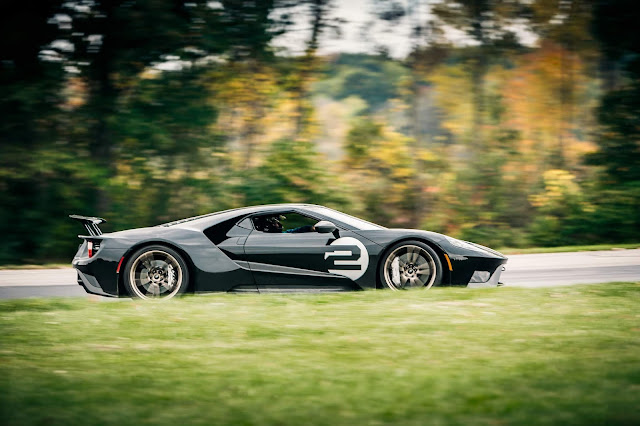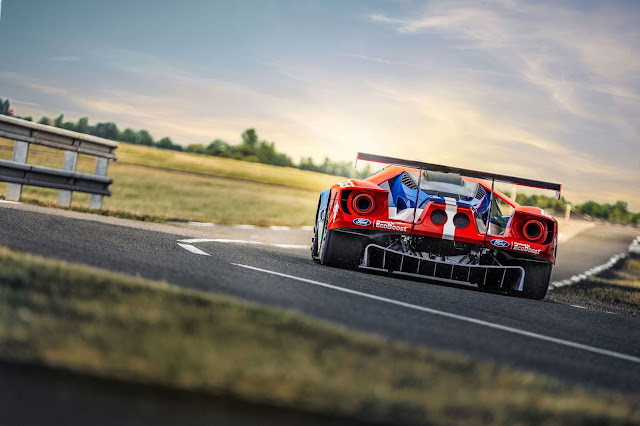The original Ford GT40 needs no introduction. It achieved instant race car celebrity status in 1966 when it did what was thought to be impossible; give a humble American car manufacturer like Ford the opportunity to beat the elite Ferrari at Le Mans. Most people know the highlight of the back story too. To spare you all the details, Ford was moving forward towards a deal to buy out Ferrari. Ferrari was interested, but Enzo Ferrari wanted to run their open wheel division themselves with full liberty. Ford didn't agree and Enzo pulled out of the deal.
Angered by that, Henry Ford (junior) wanted to show Ferrari that Ford could beat them at their own game so they went out to build a race car to win at Le Mans. What isn't very well known, however, is the fact that Ford struggled at first. Ford (naturally) went to established European manufacturers that had experience racing, likely expecting that the American racing builders would know nothing about winning at Le Mans. Unfortunately, it didn't work too well at first. It ran into teething issues in its first year in 1964 and didn't win anything the whole year with multiple DNF's (Did Not Finish).
Ford then went to a familiar name; a then-young Carroll Shelby. It dropped off the race cars and basically asked him to make them work. The Shelby magic manifested itself in 1965 and Ford won with Shelby's help at Daytona, then called Daytona 2000 which was run as a 2,000 km endurance race instead of 24 hours (interestingly, Ferrari was a 2-time Daytona Champion at the time with the legendary 250 GTO so the GT40 had started taking the crown away from Ferrari on its own turf first).
Following that, Ford and Shelby won again a month later at the Sebring 12 hour endurance race. Armed with experience and knowledge, Ford returned in 1966 to Daytona, which had just switched to a 24 hour format. Ford and Shelby won again with three Ford GT40's taking the three top podium spots. A month later, the exact same thing happened with all three top spots going to Ford GT40's at the 12 Hours of Sebring race. That ultimately led to the iconic finish at Le Mans with three GT40's once again winning the three top spots and, of course, beating Ferrari. It then went on to win for 4 consecutive years; from 1966 to 1969.
It's one of the best race car stories out there and that fact means any Ford GT has huge shoes to fill. The "second generation" Ford GT, which came out in 2004, was not a true successor to the GT40 in my opinion. Don't get me wrong, it was a fantastic thing. It is on my must-drive bucket list of cars and think it should be on everyone's list. But it was a tribute. It was an excellent tribute, but a tribute nonetheless. It just couldn't trace its own roots in racing. It didn't come out with the purpose and focus of the original; track dominance. The current Ford GT, though, is different.
Back in the day, it was much more common for production cars to be homologated cars to allow competition in racing. Such was the case for the original BMW M3, for example. The original Mustang Boss 302 and Camaro Z/28, original (C2) Corvette Grand Sport, a myriad of Porsches, etc. That isn't the case anymore, though, as you can see by the rarity of modern homologation cars listed on FIA's website (link: FIA Historic Database - Homologation Cars). Porsche, for example, has 59 cars listed and non of them (that's zero) are from the year 2000 or newer and only 4 are 1990's cars. The GT, then, is a breath of fresh air of true racing-based development.
I don't know if Ford first decided they want to race a factory mid engine car or they first wanted to produce another Ford GT and wanted it to be a thoroughbred. But that matters little at this point, because this Ford GT had already completed an entire season of racing in 2016 before Ford rolled even a single road going version off the production line. This is your first clue about how serious this car is. But there are more similarities too.
Like the original GT40, Ford also ran into some teething issues at first with the new one, although not nearly as bad and didn't last as long. In its debut race in 2016, two Ford GT's finished 7th and 9th in their GTLM class. Not as bad as a DNF, but nothing to write home about. Ford got its act together, though, and at the 2016 Le Mans 24 Hour Race - 50 years after its iconic 1-2-3 finish in 1966 at Le Mans, it won its class and even managed to take the top two podium spots; 1st and 2nd in LMGTE Pro. And at the next Daytona 24 Hour race in 2017, it won its GTLM class and also managed two podiums; 1st and 3rd.
Its winning streak wasn't as dominant as back in the 60's, but the car proved that it was very competitive with multiple podiums at Daytona, Sebring, and Le Mans in addition to its wins, which is more impressive given Ford's lack of comparable experience to the top competitors; the Porsche, Ferrari, and Corvette factory-backed racing teams. That means the new car has pedigree in spades. No one can say it's just a tribute like the last Ford GT. But if you're one of the fans, you may have some explaining to do every time you hear something along the lines of, say... why does it have a V6??
As far as car news, learning that the GT won't have another V8 like the last one and the original was one of the worst. But then, I am almost ashamed to admit, I started to warm up to the idea.
For starters, this engine has been racing in a Daytona Prototype with Michael Shank Racing since the 2014 season. That gives it pedigree. If that's not enough, it has set the fastest lap (ever) on the Daytona oval of 40.364 seconds, beating even NASCAR race cars that should rule the Daytona 500 oval.
It also set a new record top speed of 222.971 mph, blowing the previous record of 210.364 mph out of the water. And it set a new record for the first 10 kms and the first 10 miles from standing starts. If the only problem you have with the engine is the number of cylinders vs a competitor with eight or more cylinders, then fight fire with fire. It may be down on number of cylinders but it's (very) up on number of records. But for me, and many car guys, numbers aren't the only thing that matters. But here, too, the little 3.5 litre V6 makes a very strong case for itself.
For starters, it has the same soul and good, humble nature that the previous engine had. It's based on a truck engine, just like the 5.4 litre supercharged V8 in the last Ford GT was. It's a working class hero, as Jeremy Clarkson put it multiple times. Then you get to packaging, where the smaller engine means a smaller engine bay that allows for the stunning teardrop shape with the flying buttresses where the air-to-air intercoolers live. That, in turn, also allows for excellent aerodynamics.
Well, what about noise? How could a V6 stand up to the V8's in Ferrari's and McLaren's? Well, it actually turned out to be far better than I expected. Fast forward to about 6:08 in video below to hear it from idle to WOT in a 1/2 mile run drag race. It sounds guttural and burbly at low rpms and almost like a small high-strung V8 at high rpms. The almost high strung V8-like noise may be harder to tell in the video because of the wind noise, but you can better tell when the car slows down and is downshifting at about 6:34 in. It's astonishing.
I actually enjoy hearing it now, and that's far more than I can say for any downsized engine that replaces a previously bigger, naturally aspirated engine with a higher cylinder count. Don't get me wrong, I still would have preferred to see a V8 in there, but I cannot reasonably defend the preference in any way. I can only say I just prefer a V8 and leave it at that.
When all of the above is combined, it draws a phenomenal picture. It's a stunning mid engine supercar with legendary heritage, forged in the fire of motorsport with multiple wins, powered by a record-breaking engine, and goes, drives, and sounds like nothing else. More importantly, it draws a picture of a legendary name attached to a car that is worthy of it. And tomorrow, you should tune in to watch another battle between it, Ferrari, and a grid of other magnificent race cars.
Follow Ram's Eye The Track Guy on Facebook and Instagram!



















Comments
Post a Comment